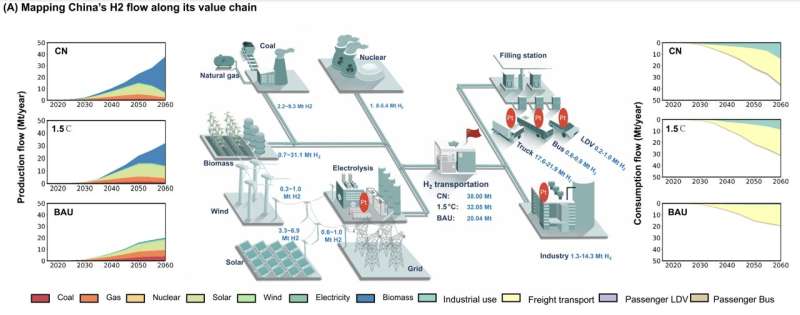This article has been reviewed according to Science X's editorial process and policies. Editors have highlighted the following attributes while ensuring the content's credibility:
fact-checked
peer-reviewed publication
proofread
Platinum circularity underpins China's green hydrogen future

A study explores the role of platinum in shaping the future of green hydrogen development in China. Hydrogen fuel is one of China's key strategies to achieve national energy security and carbon neutrality. Hydrogen is expected to provide more than 10% of China's total energy supply by 2050, and the country has announced more than 50 large-scale hydrogen projects.
Platinum plays a crucial role throughout the hydrogen value chain from production to final consumption, and this scarce metal could be a limiting factor in China's expansion of hydrogen fuel use.
Wei-Qiang Chen and colleagues model the potential pathways of China's hydrogen-fuel industry and the corresponding platinum constraints under three emissions scenarios. The study is published in the journal PNAS Nexus.
In the study's models, solar- and wind-powered electrolytic hydrogen production would rapidly expand before 2050 in all three scenarios, as would hydrogen use as freight transport fuel—assuming the cost of fuel cell electric vehicles declines to reach parity with battery electric vehicles within a decade.

Under the scenario in which China achieves carbon neutrality by 2060, the country's demand for platinum associated with hydrogen would increase from 0.6 tons per year in 2020 to 242 tons per year in 2060, which would require a substantial expansion of the country's platinum supply. This could pose risks, as 95% of platinum is currently sourced from three countries: South Africa, Russia, and Zimbabwe.
Factors such as geopolitical conflicts, labor disputes, and environmental, social, and governance risks could choke the supply of this scarce metal and price fluctuations are to be expected. Along with enhancing international cooperation in stabilizing platinum mineral supply, the authors recommend China pursue a platinum circular economy as a key strategy in its hydrogen planning.
More information: Peng Wang et al, Incorporating platinum circular economy into China's hydrogen pathways toward carbon neutrality, PNAS Nexus (2024). DOI: 10.1093/pnasnexus/pgae172


















